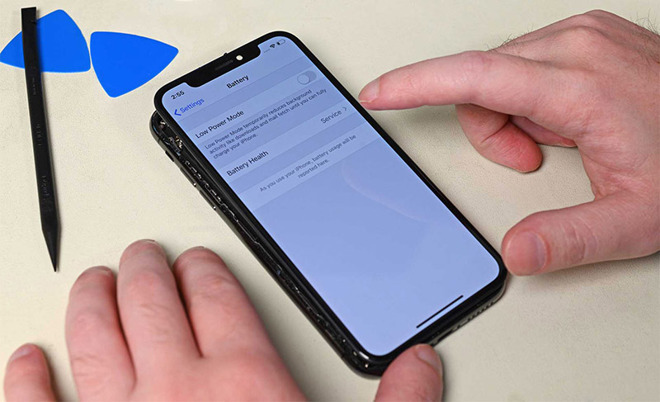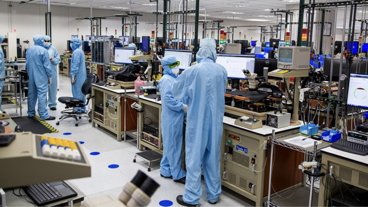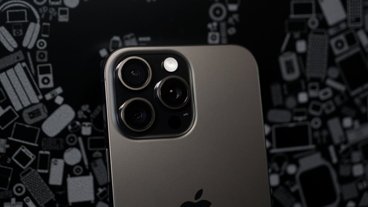Apple's 'Service' battery message in the iPhone XR, iPhone XS, and iPhone XS Max Battery Health bar following a battery replacement outside of Apple's authorized repair network is doing its job, Apple has confirmed, with the warning a safety measure for users that doesn't affect how the installed battery functions at all.
Reports in early August revealed the existence of a "Service" message in the iPhone's Battery Health section of the iOS Settings app. The notification appears in instances when the battery has been replaced by an alternate component, and will display if the replacement was installed by a third-party firm not authorized by Apple to perform repairs, even if it is a genuine component.
The battery notification only applies to Battery Health for the iPhone XR, iPhone XS, and iPhone XS Max, when the handset is put through a battery repair via an unauthorized repair shop.
In a statement provided to AppleInsider, Apple insisted "We take the safety of our customers very seriously, and want to make sure any battery replacement is done properly." Apple points out it has over 1,800 Apple authorized service providers across the United States, so there is ample opportunity for customers to go through an official repair process with genuine parts.
"Last year we introduced a new feature to notify customers if we were unable to verify that the battery was genuine and installed by a certified technician following Apple repair processes," referencing the Service message. The notification is there to help protect customers from "damaged, poor quality, or used batteries which can lead to safety or performance issues," which could be the case for components from third-party battery firms outside the Apple supply chain.
Apple also advises the message's appearance does not affect the ability to use the iPhone at all, even after an unauthorized repair.
Testing by iFixit found the message appeared even if the component installed into the iPhone was a genuine Apple battery, indicating it requires an Apple Genius or Apple Authorized Service Provider for the message to work on the iPhone to remove the message.
Unverified batteries are not able to be monitored by the Battery Health function, with maximum capacity and peak performance capacity metrics also not registering on the device.
Battery Health was introduced following the discovery Apple artificially throttled the CPU performance of iPhones with degraded batteries, in an attempt to prevent them from unexpectedly shutting down. Battery Health gave consumers a way to see if their battery was running poorly, and if it was in need of replacement.
For a period of time, Apple also started a battery replacement program that reduced the cost of out-of-warranty battery replacements from $79 to $29. The program was popular, with 11 million batteries replaced in 2018, nine times the usual number.
The full statement reads:
"We take the safety of our customers very seriously and want to make sure any battery replacement is done properly. There are now over 1,800 Apple authorized service providers across the US so our customers have even more convenient access to quality repairs.Last year we introduced a new feature to notify customers if we were unable to verify that the battery was genuine and installed by a certified technician following Apple repair processes. This information is there to help protect our customers from damaged, poor quality, or used batteries which can lead to safety or performance issues.
This notification does not impact the customer's ability to use the phone after an unauthorized repair."
 Malcolm Owen
Malcolm Owen







-m.jpg)






 Charles Martin
Charles Martin
 Marko Zivkovic
Marko Zivkovic
 Andrew Orr
Andrew Orr
 Amber Neely
Amber Neely

 William Gallagher and Mike Wuerthele
William Gallagher and Mike Wuerthele










45 Comments
So it does affect the use of the phone, as you can no longer see the battery health, despite the phone knowing that data, and it seemingly will not go into "peak performance protection" mode. Ok then.
I think Apple's approach is reasonable. Thirty years ago, I designed battery powered medical instrumentation (including defibrillators) containing rudimentary "gas gauge" hardware/firmware in the battery packs that allowed cell life and capacity to be monitored far more accurately than in previous systems. A couple years after introduction, we started getting field failure reports of batteries going dead unexpectedly while the gas gauge was indicating half a tank, or of warnings from our software that recently refurbished battery packs were worn out.
Customers were replacing the cells in our packs with generic cells of about half the capacity, because they were far less expensive. On the first charge cycle, those new cells were delivering half the energy expected by our battery monitoring system and our firmware wasn't able to cope with such a large (and out of spec) change in component behavior. A large system customer asked us to disable or modify our firmware to allow use of those lower capacity aftermarket replacement cells. We refused. It was our contention that the end customer for our products was the patient who's care was affected by our product's performance. Were we not about to let unskilled health care providers dictate to us the parameters for safe and effective operation of our products.
There might be umteen hundred Apple authorised service centers around the US, sure. But the world is bigger than the US, and Apple products are used arond the globe. Some countries, like the one where I service Apple products, have no official Apple presence at all. Battery replacement is dead simple to do really, any tech savvy person can do it. If Apple wanted to make sure replaced batteries are working the way they should, the better road to take would be to institute an MFI program for 3rd party batteries. I would be happy to get mine from a MFI certified manufacturer, the market for 3rd party batteries are for the most part completely opaque and it's really difficult to know anything much about the quality of the batteries you do take in. Which is a bummer for me and my business and a bummer for my customers.